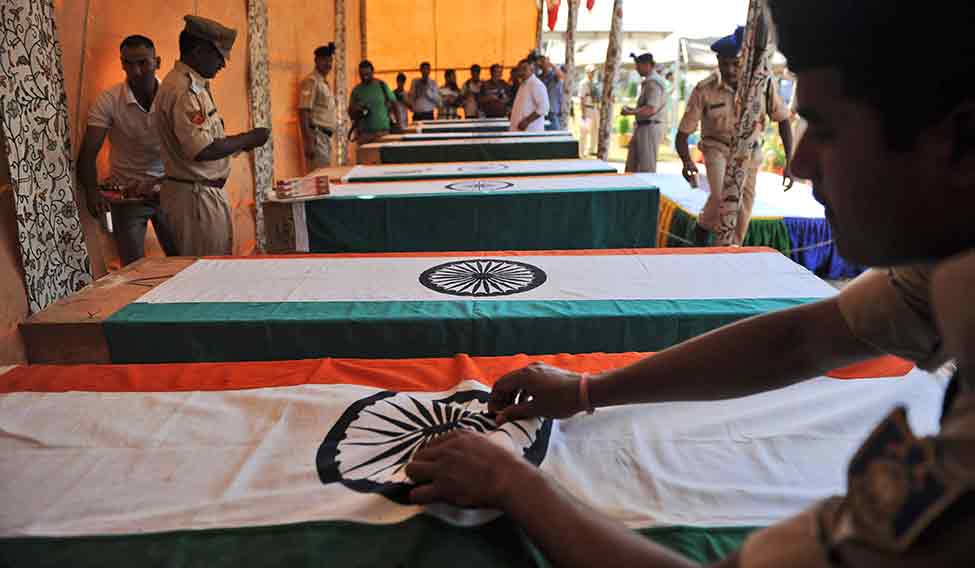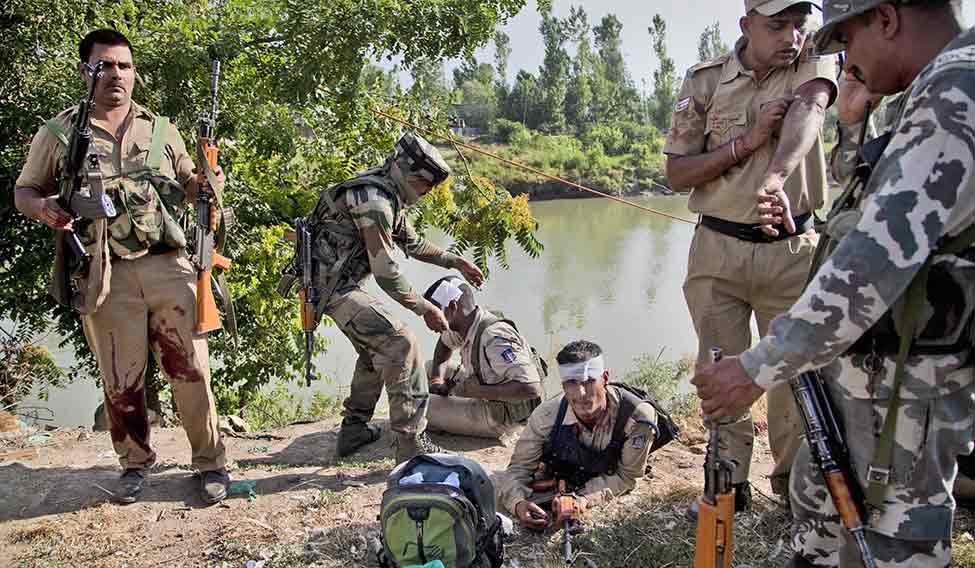When a Central Reserve Police Force convoy left Lathpora for Srinagar after a firing exercise on June 25, it had no idea that its movements were being tracked by the Lashkar-e-Taiba. The road opening party (ROP), responsible for clearing roadside bombs and mines, had noticed nothing suspicious. When the convoy reached Pampore, about 15km from Srinagar, two LeT militants fired at one of the buses carrying 40 CRPF men. The militants, who were part of a freshly infiltrated group, shot out the tyres and rained bullets on the bus. Eight CRPF men were killed and 22 were injured, five of them seriously. If the militants had succeeded in forcing open the door of the bus, the casualties would have been much higher.
Police sources said the LeT had chosen the most vulnerable spot on the Srinagar-Jammu national highway, where traffic always slowed down because of a bend. The attack came barely three days after Chief Minister Mehbooba Mufti told the state assembly that only 145 militants, including 54 foreigners, were active in the state. What she didn't say was that most of them were operating in south Kashmir—home to the ruling PDP—and were frequently targeting the vital Srinagar-Jammu national highway, the valley's lifeline.
Days before the attack, there were intelligence reports about the possibility of a terrorist strike in Srinagar during Ramzan. Intelligence officials are not ruling out the possibility that the two terrorists were on their way to Srinagar to execute an attack. The duo had shaved their bodies, possibly in preparation for a suicide strike. Moreover, the grenades recovered from them bore a direct resemblance to the ones used by the Pakistan army. "These were not Chinese grenades and resemble the ones manufactured by the Pakistan Ordnance Factories. They had no markings. If they had any markings earlier, it had been removed," said an official who visited the site of attack. According to intelligence officials, the slain men were part of a group of four and the remaining two could be planning another attack.
Sources told THE WEEK that at least 20 LeT militants, including six Pakistanis, were active in south Kashmir and most of them preferred the Sambora-Kakapora-Galandar-Bijbehara area along the highway as launching posts for attacks. The June 25 attack was ordered by Abu Dujana, the LeT's Kashmir operations' chief. Recce and logistics were managed by senior commander Roohul Amin Dar. Another LeT commander Majid Zargar was the point man between the foreign militants and the locals. Zargar coordinates the movement of fresh LeT infiltrators. Intelligence sources said the Hizbul Mujahideen led by Burhan Muzaffar Wani also helped the LeT in south Kashmir.
This year, 60 militants and 30 security personnel have lost their lives in encounters. Of these, 20 deaths were the result of highway attacks. The spate of attacks on the highway is seen as a ploy by Pakistan to force greater deployment of troops on the 300-km-long national highway. This will also create a negative impression in the minds of visitors who travel to Kashmir by road. A large presence of troops along the highway creates an impression of Kashmir being a battle zone, giving the militants a massive propaganda edge.
A senior government official said the attack happened because of the glaring gaps in the intelligence and security set up, which not only allowed infiltration to take place, but also failed to detect and stop terrorists who used the highway. The security forces had intercepts of terrorists' exchanges at every stage of the infiltration from across the border, starting from the Line of Control. There were intercepts which said "they are going to enter", "they have entered" and "they are ready for their task", said a senior intelligence official.
 Salute, martyrs: Eight CRPF jawans lost their lives in the Pampore attacks as the LeT stepped up ambushes along the Jammu-Srinagar highway | AFP
Salute, martyrs: Eight CRPF jawans lost their lives in the Pampore attacks as the LeT stepped up ambushes along the Jammu-Srinagar highway | AFP
A THREE-MEMBER home ministry team comprising secretary for border management Susheel Kumar, special secretary for internal security Mahesh Kumar Singla and joint secretary (Kashmir Affairs) Gyanesh Kumar reached Srinagar on June 29 for a review of the security scenario. The team is interacting with various security agencies and discussing measures to foil the plans of the terrorists. CRPF director-general K. Durga Prasad said there was a problem as far as vehicle checking was concerned. "I do not have information on how the infiltration took place. Once the investigation is complete, we will know exactly how it happened,” said Prasad. He said the security forces would increase the frequency of vehicle checks at more places across the valley and stressed the importance of equipping CRPF convoys with bullet-proof vehicles, like in the Army. The home ministry is rushing several mine-proof vehicles from Naxal-infested areas to Kashmir.
There are also questions whether the Army could have provided better protection to CRPF convoys. "The 51 Rashtriya Rifles unit reached the spot after the incident," said Prasad. A controversy erupted soon after as the Army's northern command tweeted about the "joint operation" to kill the militants, only to be reminded by the CRPF brass that its jawans should be given the credit for the operation in which they had laid down their lives. The Army later retracted the tweet and gave credit to the CRPF. The episode, however, left a bitter taste in the mouth as the claim for credit was unjustified when many had lost their lives. ''We suffered casualties in the Pampore attack, but we did not allow the militants to flee and eliminated them on the spot,” said Nalin Prabhat, CRPF inspector-general.
The Jammu and Kashmir Police suspects the involvement of surrendered militants in the Pampore attack. The car driver who dropped off the two terrorists on the highway was a surrendered militant. "If this is true, then it is a matter of worry as there could be more cases where militants are taking the benefit of the surrender and rehabilitation policy,” said a home ministry official.
Another worry for the government is that terror outfits are gaining in popularity, especially among the local youth. "Our assessment is based on comparatively low voter turnouts and a high level of presence for the funeral of the slain militants," he said. “This time, it is the educated youth and not the poor and unemployed who are taking to militancy. Moreover, social media has become an active hunting ground for militant outfits and indoctrination of youth from the valley," said the official.
Although the Army has successfully foiled most infiltration attempts, at least 20 militants have managed to infiltrate this year from Pakistan-occupied Kashmir. Surprisingly, militants are now trying to infiltrate even through the Uri sector in Baramulla in north Kashmir, which has been difficult to penetrate.
The heightened militant activity in the state has further complicated matters for the coalition government. Mehbooba called the attacks un-Islamic. “I fail to understand how somebody can indulge in such senseless acts of blood-letting in the name of Islam and that, too, in the holy month of Ramzan, the month of peace and blessings for the people,” she said. “Such attacks won’t prove anything, but can only defame Kashmir.''







